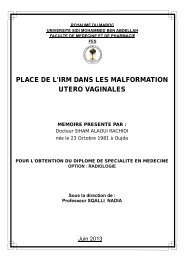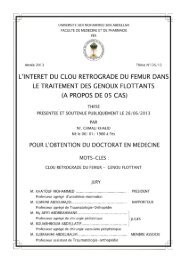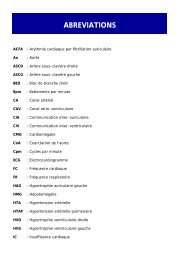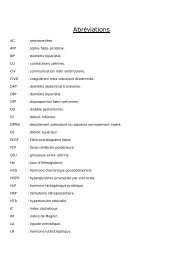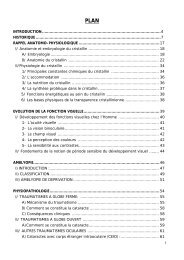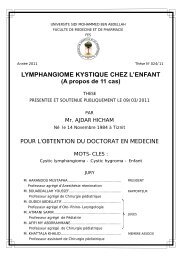I. Les facteurs associés à la « non reperfusion - Faculté de ...
I. Les facteurs associés à la « non reperfusion - Faculté de ...
I. Les facteurs associés à la « non reperfusion - Faculté de ...
Create successful ePaper yourself
Turn your PDF publications into a flip-book with our unique Google optimized e-Paper software.
PLAN DU TRAVAIL<br />
INTRODUCTION ...............................................................................................<br />
MATERIEL ET METHODES ..................................................................................<br />
1- Critères d’inclusion et d’exclusion .................................................<br />
2- Mo<strong>de</strong> <strong>de</strong> recueil <strong>de</strong>s données .........................................................<br />
3- Paramètres étudiés ........................................................................<br />
RESULTATS ....................................................................................................<br />
NOTRE TRAVAIL EN BREF ..................................................................................<br />
DISCUSSION ....................................................................................................<br />
AMPLEUR DU PROBLEME ........................................................................................<br />
I. L’IDM <strong>non</strong> revascu<strong>la</strong>risé, état <strong>de</strong>s lieux ...........................................<br />
II. Le pronostic <strong>de</strong>s IDM <strong>non</strong> revascu<strong>la</strong>risés .........................................<br />
POURQUOI NE SONT-ILS PAS REVASCULARISES .....................................................<br />
I. <strong>Les</strong> <strong>facteurs</strong> <strong>associés</strong> <strong>à</strong> <strong>la</strong> <strong>«</strong> <strong>non</strong> <strong>reperfusion</strong> » chez les patients admis<br />
dans les 12 première heures du début <strong>de</strong>s symptômes .......................<br />
1. La <strong>reperfusion</strong> spontanée ..................................................<br />
2. Autres <strong>facteurs</strong> liés <strong>à</strong> <strong>la</strong> <strong>non</strong> <strong>reperfusion</strong> ..............................<br />
II. <strong>Les</strong> patients admis au <strong>de</strong>l<strong>à</strong> <strong>de</strong>s 12 première heures du début <strong>de</strong>s<br />
symptômes ...................................................................................<br />
1. <strong>Les</strong> bénéfices <strong>de</strong> <strong>la</strong> <strong>reperfusion</strong> précoce .............................<br />
2. Quelle stratégie au-<strong>de</strong>l<strong>à</strong> <strong>de</strong> <strong>la</strong> 12ème heure : <strong>la</strong> théorie <strong>de</strong><br />
l’artère ouverte ................................................................<br />
3. les indication <strong>de</strong> <strong>la</strong> revascu<strong>la</strong>risation au-<strong>de</strong>l<strong>à</strong> <strong>de</strong> <strong>la</strong> 12 ème<br />
heure ................................................................................<br />
POURQUOI ILS CONSULTENT TARDIVEMENT ? .......................................................<br />
1



